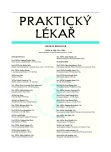Evoluce a evoluční teorie pro lékaře
XI. Vývoj jazyka
Authors:
F. Koukolík
Authors‘ workplace:
Primář: MUDr. František Koukolík, . DrSc.
; Národní referenční laboratoř prionových chorob
; Fakultní Thomayerova nemocnice s poliklinikou, Praha
; Oddělení patologie a molekulární medicíny
Published in:
Prakt. Lék. 2010; 90(11): 632-635
Category:
Editorial
Overview
The evolution of human language is a matter of controversy. Hauser-Fitch-Chomsky’s hypothesis distinguishes between faculty of language in the broad sense, which includes sensory-motor system and conceptual-intentional system, and faculty of language in the narrow sense (FLN), which is a computational system for recursion. FLN should be the only unique human component of the faculty of language. This hypothesis is subject to much criticism: it ignores non-recursive aspects of grammar, is inconsistent with the anatomy and neural control of the human vocal tract e.g.
Arbib-Rizzolati’s hypothesis starts with the “mirror system” and offers hypotheses on evolutionary changes within and outside the mirror system which may have equipped our ancestors with a language-ready brain.
Christiansen – Chater’s hypothesis states that a language is shaped by the brain, biologically determined universal grammar is not evolutionary viable: the language has been shared to fit the brain, rather than vice versa.
Key words:
language evolution, Hauser-Fitch Chomsky’s hypothesis, Rizzolati-Arbib’s hypothesis, Christiansen-Chater’s hypothesis.
Sources
1. American Heritage Dictionary of the English Language. 4th ed. Houghton Mifflin Co., 2000, updated 2009.
2. Arbib, M.A. Beyond the mirror system: imitation and evolution of language. In: C. Nehaniv, K. Dautenhan (eds). Imitation in animals and artifacts. Cambridge (Mass): MIT Press 2002, p. 229-280.
3. Arbib, M.A. From monkey-like action recognition to human language: an evolutionary framework for neuroliguistics. Behav. Brain Sci. 2005, 28, p. 105-124.
4. Balter, M. Language evolution: „speech gene“ tied to modern humans. Science 2002, 297, p. 1105.
5. Dunbar, R.I.M. Coevolution of neocortex size, group size and language in humans. Behav. Brain Sci. 1993, 16, p. 681-735.
6. Fischer, S.E., Vargha-Khadem, F., Watkins, K.E. et al. Localisation of a gene implicated in a severe speech and language disorder. Nat. Genet. 1998, 18, p. 168-170 (Erratum in Nat. Genet. 1998; 18: p. 298).
7. Fitch, W.T., Hauser, M.D. Computational constraints in syntactic processing in a nonhuman primate. Science 2004, 303, p. 377-380.
8. Fodor, J.A. The modularity of mind: an essay on faculty psychology. Cambridge (Mass): MIT Press, 1983.
9. Gould, S.J. The limits of adaptation: is language a spandrel of human brain? Cognitive Science Seminar, Center for Cognitive Science, Massachusetts Institute of Technology, October 1987.
10. Hauser, M.D., Chomsky, N., Fitch, W.T. The faculty of language: what is it, who has it, and how did it evolve? Science 2002, 298, p. 1569-1579.
11. Heine, B., Kuteva, T. Language contact and grammatical change. Cambridge (UK): Cambridge University Press, 2005.
12. Chomsky, N. Syntactic structures. New York: Mouton Publishers, 1957.
13. Chomsky, N. Rules and representations. Oxford: Blackwell, 1980.
14. Chomsky, N. Language and problems of knowledge. The Managua lectures. MIT Press, 1988.
15. Christiansen, M.H., Chater, N. Language as shaped by the brain. Behav. Brain Sci. 2008, 31, p. 489-558.
16. Christiansen, M.H., Chater, N., Reali, F. The biological and cultural foundations of language. Commun. Integr. Biol. 2009, 2-3, p. 221-222.
17. Lai, C.S.L., Fisher, S.E., Hurst, J.E. et al. A forkhead-domain gene is mutated in severe speech and language disorder. Nature 2001, 413, p. 519-522.
18. Lai, C.S.L., Gerrelli, D., Monaco, A.P. et al. FOXP2 expression during brain development coincides with adult sites of pathology in a severe speech and language disorder. Brain 2003, 126, p. 2455-2462.
19. Pinker, S. The language instinct. New York: Harper Collins, 1994.
20. Pinker, S., Jackendoff, R. The faculty of language: what´s special about it? Cognition 2005, 95, p. 201-236.
21. Rizzolatti, G., Arbib, M.A. Language within our grasp. TINS 1998, 21, p. 188-194.
22. Senghas, A., Kita, S., Özyürek, A. Children creating core properties of language: evidence from an emerging sign language in Nicaragua. Science 2004, 305, p. 1779-1782.
23. Siegal, M. Signpost to the essence of language. Science 2004, 305, p. 1720-1721.
24. Tomasello, M. Origins of human communication. Cambridge(Mass): MIT Press, 2008.
25. Vargha-Khadem, F., Watkins, K.E., Price, C.J. et al. Neural basis of an inherited speech and language disorder. Proc. Natl. Acad. Sci. USA 1998, 95, p. 12695-12700.
Labels
General practitioner for children and adolescents General practitioner for adultsArticle was published in
General Practitioner

2010 Issue 11
- Hope Awakens with Early Diagnosis of Parkinson's Disease Based on Skin Odor
- Memantine Eases Daily Life for Patients and Caregivers
- Memantine in Dementia Therapy – Current Findings and Possible Future Applications
- Metamizole vs. Tramadol in Postoperative Analgesia
- What Effect Can Be Expected from Limosilactobacillus reuteri in Mucositis and Peri-Implantitis?
Most read in this issue
- Antiaggregation and gastroprotective drugs
- Testosterone and lifestyle diseases
- Trace elements and bone
- Alcohol, tobacco, drugs and reproductive risks
